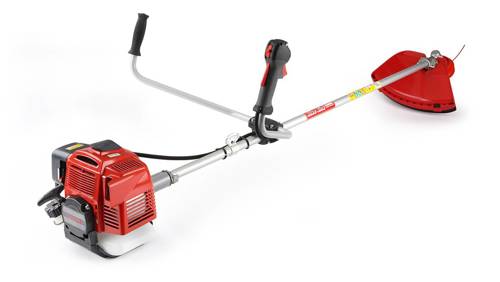BUY THE BEST BRUSHCUTTER: commercial brushcutter buyer’s guide
8 Apr 2022 Buyer's Guides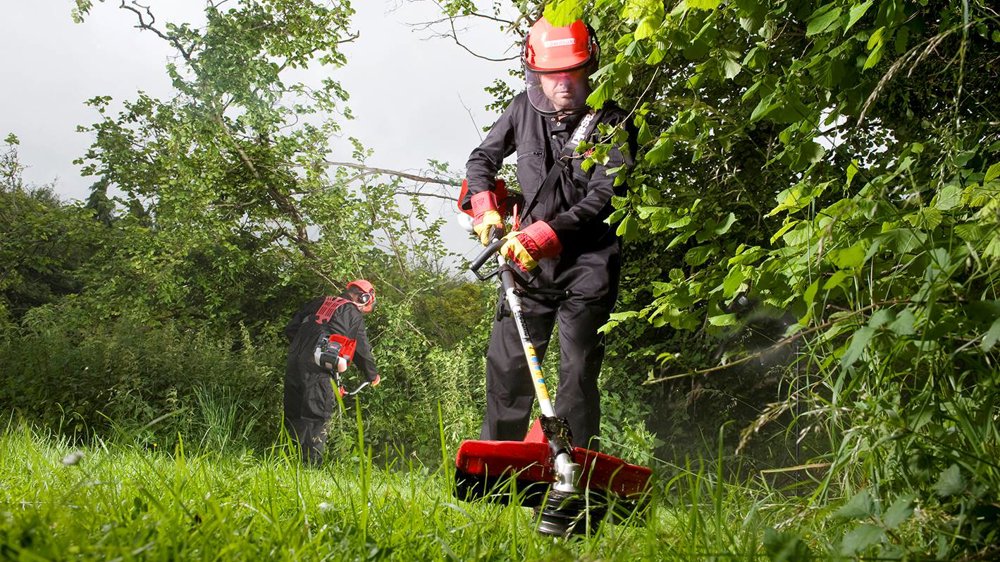
Versatile and powerful, the brush cutter is an essential power tool for landscape gardeners and grounds teams. Equipped with a metal blade or nylon line, this piece of kit is perfect for strimming long grass and weeds. The more powerful - professional - models will be able to tackle more dense overgrowth and even shrubs and bushes.
This commercial buyers’ guide is for landscapers and professional gardeners to ensure you buy the right machine for your business. It offers a number of key factors to think about, from the nature of your business to features for comfortable use and which manufacturers to consider.
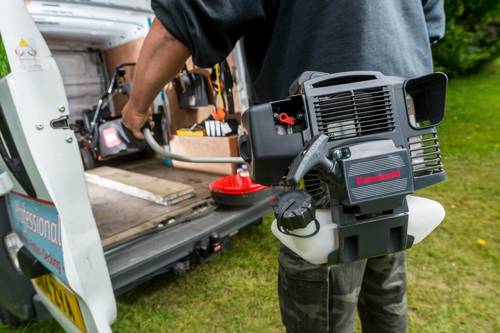
The landscape
Size and scale
How big are the gardens or spaces you have to maintain? What is the type and condition of the vegetation?
The denser the growth the more power you will need. If you’re dealing with small shrubs, dense overgrowth and scrub, it’s worth considering something with a larger engine, particularly if you have a lot of rural ground to cover. Well-maintained domestic gardens may suit slightly less powerful machines but lower power can restrict the kind of work you're able to do. A powerful engine will give you the versatility to tackle any job you might be faced with.
Frequency of use
For professional contractors, a brush cutter may get used every day of the week for extended periods, so a durable and reliable machine is a must. A purchase is an investment and you might spend in the region of €800 per tool - though cheaper non-professional prices can be around €200-€235. Please note that prices may vary from country to country.
If you use your brush cutter frequently, it’s worth investing in a more expensive product. A higher cost can mean higher quality parts are used to manufacture the product, more sophisticated engineering is built-in, usually with greater power and extended durability. By avoiding downtime due to maintenance and repair, you avoid time not working – and if you’re not working, you’re not earning.
The machine
Comfort
Operating a brush cutter can be physically demanding, particularly if they are required to be in operation for hours at a time.
There are a number of factors which can determine user comfort:
Harness
Add an ergonomic harness to ensure the weight of the machine is held by a comfortable area of the body. A harness will help your shoulders and upper back take the weight of the brushcutter, rather than your arms and lower back. You can opt for a single or double harness; a double harness type is generally better suited for operating more powerful and heavier machines.
Type of handle
Brush cutters come with either loop handles or bike handles for user control. Loop handles generally give good control around curves such as flower beds or shrubs or when clearing up small areas, whilst the bike handle is better if there is a large area to maintain as it can be operated with a swaying or sweeping motion.
Vibration dampening
Anti-vibration technologies were introduced for operator comfort, occupational health and can greatly reduce operator fatigue while working. These are important points. Exposure to tool vibration for extended periods can lead to the loss of feeling in fingers, pins and needles and even pain. Some of these symptoms can become permanent and affect dexterity. Add this to your priority list if the machine will be used for prolonged periods.
Controls
Many manufacturers offer simple, ergonomically positioned controls for ease of use, and systems to make the engine pull-start easy and reliable. The less effort it takes to start the brush cutter and the more comfortable it is to operate, the easier your working day will be. Try different machines to ensure the one you choose feels comfortable and can be operated with low effort.
Noise levels
Ideally, users should wear protective equipment when operating brush cutters (goggles and noise-cancelling headphones are advised), but environmental noise levels are also an important factor, especially if the machinery is going to be used near schools or offices where excessive noise could be disruptive.
Weight and size
Brush cutters require lifting in order to be operational so opt for a machine weight you can comfortably manage. Manufacturers often produce a range from heavy-duty to more nimble products, all measured in kilograms. It is important to assess the impact of extended use on your body and whether harnesses can reduce discomfort.
Give thought to the size of the model too. If you need to transport the machinery, will it be too cumbersome, or can it fit comfortably into a storage shed or van? Consider a foldable handle model if storage space is minimal.
Maintenance
If you’ve opted to invest in a high-quality model, it’s crucial that you’re prepared to maintain and look after it. It will not only repay you with years of service, but it ensures it will operate safely. For example, regularly checking and changing air filters.
Be prepared to find out how to take care of your brush cutter or find a local dealer who can service, troubleshoot and replace parts.
Refer to the owner's manual for recommended maintenance checks or before undertaking any maintenance work.
Technical specifications
Engine size and power
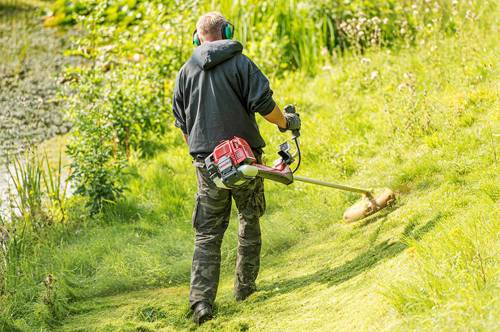
Cubic Centimetres (cc) relates to the size of the engine and gives an indication of how powerful the brush cutter will be. The bigger the cc, the more powerful the brush cutter is likely to be and the better suited to dealing with tough workloads like dense scrub, thick grass or weeds.
Power is essential for speed, which is in turn essential for a good cut. But power is also important for torque. With low power and low torque, brush cutters will fail to cut through thicker stems and slow down - reducing the effectiveness of the whole cut. As a professional, think about the range of work you'll need your brush cutter to cope with and choose your engine size accordingly. Consider the quality advantages in opting for a specialist, well-known engine brand rather than a low-cost, unbranded alternative that may not be suited to the demands of commercial work.
Petrol vs electric
The petrol vs electric conversation has two main elements for professional landscapers: which offers suitable power and durability? And which is the most environmentally friendly? Consider the pros and cons of both, and decide what’s right for you.
Petrol brush cutters are more powerful and offer greater flexibility for landscape gardeners and grounds teams who have large areas to cover. They can operate for long periods without the need to refuel (as long as the tank capacity is fit for purpose) and are generally more durable machines.
Electric brush cutters are usually more lightweight but come with the restriction of needing mains electricity or to be charged in advance. This throws into question the issue of battery life or how far away from an electricity source you need to work.
As well as power, environmental impact is an important factor. Electric is often the go-to choice to avoid emissions, but this choice often just moves the emissions further down the supply chain. Also, innovation and regulation are helping to reduce petrol’s impact. Since September 2021 the standard petrol grade in Great Britain has become E10 (replacing E5) in a bid to reduce CO2 emissions. E10 contains 10% renewable ethanol so less fossil fuel is needed.
Blade or nylon lines?
Nylon lines are responsible for the cutting action in the majority of grass trimmers, whereas a blade cutting system is more common in higher-spec grass trimmers and brush cutters. Blades are easy to change and more durable than line cutting systems, which require regular spool changes. Blade cutting systems are widely acknowledged as better suited for professional landscape gardeners or you might choose a brushcutter with an interchangeable head to take advantage of the benefits of both.
Fuel tank capacity
If the tank holds a large amount of fuel, the machine will naturally run for longer periods of time, making it better suited to larger jobs where there is more ground to cover. However, the larger the tank, the heavier the overall machine will be. The product spec will outline the fuel tank capacity measured in litres, giving you a useful indication of whether a model will fit with your needs.
Cutting width
The bigger the cutting width, the more grass the trimmer can clear in one go. Larger cutting widths make lighter work of larger areas more quickly, but they can be cumbersome if you need to maintain hard-to-reach or awkwardly shaped areas.
As a general rule 400mm is the ideal width for heavy-duty work, thick grass or undergrowth, whereas 200-300mm is best suited for light grass trimming on small to medium lawns.
Buying the best brush cutter
Cost
Typically ranging from around €200 to €800, there are brush cutters to suit most budgets. Models designed for commercial use tend to be more expensive but usually offer better quality and longer lifespans, providing better value in the long term. Cheaper options may look appealing but could mean sooner/more frequent repairs or replacement. You might also consider the quality of your own work, what your customers get and how long it will take to deliver. With the correct upkeep/maintenance, professionals know that the initial investment can be worth it for a high-quality, reliable product that will reduce downtime and help produce better work for their customers.
If you’re prepared to invest time into the upkeep and maintenance of your power tools, you will be rewarded with an increased lifespan of the product.
Should I listen to reviews?
Reviews are a valuable source of information that can inform your buying decision but be careful about who you trust. Research models on reputable blogs and review sites. You might also check what landscaper ‘influencers’ such as Jimmy The Mower and John Ryan are reviewing and using. While garden machinery dealers are of course in the business of selling products, they will usually stock a range of brands and are very knowledgeable about the industry and available machinery. As such, they can be a great source of valuable information.
Warranty options
Warranty is important, it ensures that you and your business continue to function and aren’t left out of pocket. A comprehensive warranty is a sign of the confidence that a manufacturer has in their machine. For example, Kawasaki covers the first two years for two-stroke engines, including unlimited hours for professionals as well as domestic use. Ensure the warranty also covers replacement, repairs or refunds.
Where to buy?
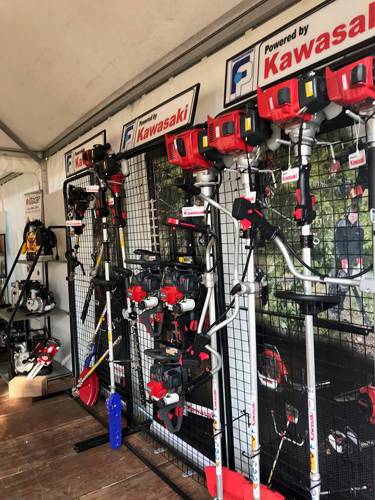
Purchasing from a dealer will enable you to tap into expert advice from a sales team and see the product in the flesh. Dealers will often offer good after-care options too.
Buying online can offer competitive prices and enable you to purchase models which aren’t available locally. However, we don’t recommend buying petrol power tools online for safety reasons as items can often rely on users having to finish assembling the product themselves.
Either way, doing your research before you visit a physical or online shop will make sure you’re better informed about your needs and less likely to make a decision you might later regret.
Examples of brush cutter manufacturers
Leading manufacturers offer a good range of brush cutters to suit all needs and requirements. Kawasaki's market-leading 2-stroke engines power the following brands available across Europe: AMA, Attila, Blue Bird Industries, COBRA, Comforex, Dormak, Ergomac, Francepower, Jasper, Kuril, MGF, Mikawa, Sport Garden, Torke, Yokoama.

